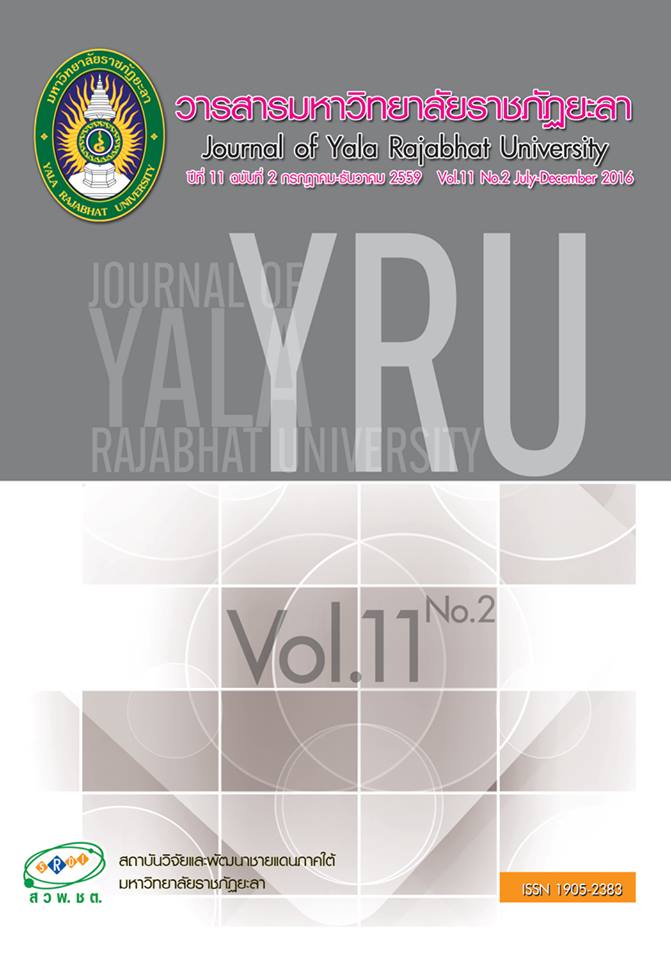ปัจจัยที่ส่งผลต่อการนำเทคโนโลยีสารสนเทศมาใช้ในอุตสาหกรรมแปรรูปอาหารขนาดกลางและขนาดย่อมของไทย
Main Article Content
บทคัดย่อ
งานวิจัยนี้ได้บูรณาการทฤษฎีสถาบัน ทฤษฎีการพึ่งพาทรัพยากร และทฤษฎีการยอมรับด้วยคุณสมบัติของนวัตกรรม มาพัฒนาเป็นกรอบแนวคิดเพื่อศึกษาหาปัจจัยที่ส่งผลต่อการนำเทคโนโลยีสารสนเทศมาใช้ในกิจการอุตสาหกรรมแปรรูปอาหารขนาดกลางและขนาดย่อมในประเทศไทย เครื่องมือที่ใช้ในการเก็บรวบรวมข้อมูล ได้แก่ แบบสอบถามโดยข้อมูลได้มาจากกิจการอุตสาหกรรมแปรรูปอาหารขนาดกลางและขนาดย่อมทั่วประเทศจำนวน 177 แห่งจากการส่งแบบสอบถามไปจำนวน 800 แห่งและการสัมภาษณ์ผู้บริหารจำนวน 8 ราย ผลจากการทดสอบสมมติฐานด้วยวิเคราะห์การถดถอยพหุคูณแบบเป็นขั้นตอน (Stepwise multiple regression) พบว่า ความเข้ากันได้ของเทคโนโลยีสารสนเทศกับปัจจัยพื้นฐานของกิจการความได้เปรียบเชิงเปรียบเทียบ การรับรู้ถึงความสำคัญของผู้มีส่วนได้ส่วนเสียขนาดกิจการ ความมุ่งมั่นของผู้บริหารและค่าใช้จ่ายในการใช้เทคโนโลยีสารสนเทศเป็นปัจจัยที่ส่งผลต่อการนำเทคโนโลยีสารสนเทศมาใช้ในกิจการอย่างมีนัยสำคัญทางสถิติที่ระดับ .05 ผลการวิเคราะห์ สมมติฐานและการสัมภาษณ์เชิงลึกผู้ประกอบการสามารถเสนอแนะในเชิงนโยบายได้ว่ารัฐควรให้การสนับสนุนและส่งเสริมการสร้างความรู้และความเข้าใจเกี่ยวกับเทคโนโลยีสารสนเทศให้กับกิจการอุตสาหกรรมแปรรูปอาหารขนาดกลางและขนาดย่อม ควรสนับสนุนกิจการอุตสาหกรรมขนาดเล็กที่ขาดแคลนเงินทุน ตลอดจนควรมีมาตรการจูงใจกิจการที่มีความตั้งใจ และยกระดับการนำเทคโนโลยีสารสนเทศมาใช้ในกิจการ ได้แก่ การใช้นโยบายทางภาษี หรือการให้กู้ยืมเงินสำหรับการสร้างระบบเทคโนโลยีสารสนเทศในอัตราดอกเบี้ยที่ต่ำ
Article Details
บทความ ข้อมูล เนื้อหา รูปภาพ ฯลฯ ที่ได้รับการเผยแพร่ในวารสารมหาวิทยาลัยราชภัฏยะลานี้ ถือเป็นลิขสิทธิ์ของวารสารมหาวิทยาลัยราชภัฏยะลา หากบุคคลหรือหน่วยงานใดต้องการนำทั้งหมดหรือส่วนหนึ่งส่วนใดไปเผยแพร่ต่อหรือกระทำการใดๆ จะต้องได้รับอนุญาตเป็นลายลักษณ์อักษรจากวารสารมหาวิทยาลัยราชภัฏยะลาก่อนเท่านั้น
เอกสารอ้างอิง
2.สมยศ นาวีการ. (2548). การบริหารเชิงกลยุทธ์. กรุงเทพฯ : สำนักพิมพ์บรรณกิจ 1991.
3.สำนักงานส่งเสริมวิสาหกิจขนาดกลางและขนาดย่อม. (2556). รายงานประจำปี 2555. กรุงเทพฯ : ผู้แต่ง.
4.Covaleski, M. A. & Dirsmith, M. W. (1988). An institutional perspective on the rise, social transformation, and fall of a university budget category. Administrative Science Quarterly, 33, 562-587.
5.Cronbach, L. (1951). Coefficient alpha and the internal structure of tests. Psychometrical, 16, 297-334.
6.Davis, F. (1985). A Technology Acceptance Model for Empirically Testing New End-User Information Systems: Theory and Results. Unpublished Ph.D. dissertation. MIT Sloan School of Management. Cambridge, MA.
7.Dimaggio, P. J. & Powell, W. W. (1983). The iron cage revisited - institutional isomorphism and collective rationality in organizational fields. American Sociological Review, 48(2), 147-160.
8.Goodstein, J. D. (1994). Institutional pressures and strategic responsiveness: employer involvement in work-family issues. Academy of Management Journal, 37, 350-382.
9.Greening, D. W. & Gray, B. (1994). Testing a model of organizational response to social and political issues. Academy of Management Journal, 37, 467-498.
10.Hair, J. F. Jr., Anderson, R. E., Tatham, R. L. & Black, W. C. (1995). Multivariate Data Analysis with Readings. (4th ed.). Englewood Cliffs, NJ: Prentice-Hall.
11.Harvey, B. & Schaefer, A. (2001). Managing relationships with environmental stakeholders: a study of U.K. water electricity utilities. Journal of Business Ethics, 30, 243-261.
12.Hong, W. & Zhu, K. (2006). Migrating to internet-based e-commerce: factors affecting e-commerce adoption and migration at the firm level. Information & Management, 43(2), 204-221.
13.Jawahar, M. I. & McLaughlin, G. L. (2001). Toward a descriptive stakeholder theory: an organizational life cycle approach. Academy of Management Review, 26, 397-414.
14.Lovea, P. E. D. & Iranib, Z. (2004). An exploratory study of information technology evaluation and benefits management practices of SMEs in the construction industry. Information & Management, 42, 227–242.
15.Oliver, C. (1991). Strategic responses to institutional processes. Academy of Management Review, 16, 145-179.
16.Pfeffer, J. & Salancik, G. R. (1978). The External Control of Organizations: A Resource Dependence Perspective. New York: Harper & Row.
17.Rogers, E. (1983). Diffusion of Innovations. (3rded.). New York: Free Press.
18.Rogers, E. (1995). Diffusion of Innovations. (4thed.). New York: Free Press.
19.Russo, M. V. & Fouts, P. A. (1997). A resource-based perspective on corporate environmental performance and profitability. Academy of Management Journal, 40, 534-559.
20.Tan, K. S., Chong, S. C., Lin, B. & Eze, U. C. (2009). Internet-based ICT adoption: evidence from Malaysian SMEs. Industrial Management & Data Systems, 109(2), 224-244.
21.Thong, J. Y. (1999). An integrated model of information systems adoption in small businesses. Journal of Management Information Systems, 15(4), 187-214.
22.Thong, J. Y. & Yap, C. S. (1995). CEO characteristics, organizational characteristics and technology adoption in small business. Omega, 23(4), 429-442.
23.Welsh, J. A. & White, J. F. (1981). A small business is not a little big business. Harvard Business Review, 59(4),18.
24.Wever, G. H. & Vorhauer, G. F. (1993). Kodak’s framework and assessment tool for implementing TQEM. Total Quality Environmental Management, 2(2), 19-30.


